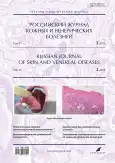Trifarotene: a new chapter in the treatment of acne. An overview of the data on efficacy and safety profile of a fourth-generation retinoid
- 作者: Snarskaya E.S.1, Olisova O.Y.1, Bratkovskaya A.V.1, Karlovskaya E.D.1, Ryabihina Y.O.1
-
隶属关系:
- The First Sechenov Moscow State Medical University (Sechenov University)
- 期: 卷 27, 编号 2 (2024)
- 页面: 219-230
- 栏目: DERMATOLOGY
- URL: https://journals.rcsi.science/1560-9588/article/view/262161
- DOI: https://doi.org/10.17816/dv629838
- ID: 262161
如何引用文章
详细
Vulgar acne is a chronic inflammatory skin disease that has a significant impact on patients' quality of life. The search for new highly effective and treatments with favorable safety profile remains relevant due to the high incidence in the population.
The launch of a 4th generation retinoid, trifarotene, which has a selective mechanism of action on RAR-γ (γ-retinoic acid receptors agonist), represents a new era in topical therapy of acne vulgaris and is of particular interest to practical healthcare.
A systematic literature overview in PubMed, Google Scholar, and ClinicalTrials.Gov databases was conducted to evaluate the mechanism of action, efficacy, and safety profile of the selective 4th generation retinoid, trifarotene 50 µg/g (0,005%) in dosage form topical cream.
In a systematic overview, 12 contemporary studies (2015–2023) were selected confirming the high efficacy of trifarotene in protocols for the treatment of acne vulgaris with localization on both facial and truncal skin. The drug demonstrates a unique ability to modulate cell adhesion, optimize transepidermal water loss and reduce the activity of membrane metalloendopeptidases, which determines its proven efficacy.
Trifarotene, an innovative 4th generation topical retinoid approved by the FDA in 2019 for the treatment of acne in patients over 9 years of age, opens new possibilities in the treatment of acne vulgaris. Its selective activity to RAR-γ receptors, proven efficacy and favorable safety profile make it a promising agent in therapeutic practice.
关键词
作者简介
Elena Snarskaya
The First Sechenov Moscow State Medical University (Sechenov University)
Email: snarskaya-doc@mail.ru
ORCID iD: 0000-0002-7968-7663
SPIN 代码: 3785-7859
MD, Dr. Sci. (Med.), Professor
俄罗斯联邦, MoscowOlga Olisova
The First Sechenov Moscow State Medical University (Sechenov University)
Email: olisovaolga@mail.ru
ORCID iD: 0000-0003-2482-1754
SPIN 代码: 2500-7989
MD, Dr. Sci. (Med.), Professor, Corresponding member of the Russian Academy of Sciences
俄罗斯联邦, MoscowAnna Bratkovskaya
The First Sechenov Moscow State Medical University (Sechenov University)
编辑信件的主要联系方式.
Email: annabratk24@gmail.com
ORCID iD: 0000-0002-7284-9113
SPIN 代码: 6012-7555
俄罗斯联邦, Moscow
Elena Karlovskaya
The First Sechenov Moscow State Medical University (Sechenov University)
Email: karlovskaya.e@inbox.ru
ORCID iD: 0009-0002-3445-7503
俄罗斯联邦, Moscow
Yulia Ryabihina
The First Sechenov Moscow State Medical University (Sechenov University)
Email: yuliaryabihina@yandex.ru
ORCID iD: 0009-0000-4209-4939
俄罗斯联邦, Moscow
参考
- Moradi Tuchayi S, Makrantonaki E, Ganceviciene R, et al. Acne vulgaris. Nat Rev Dis Primers. 2015;1:15029. doi: 10.1038/nrdp.2015.29
- Nandy P, Shrivastava T. Exploring the multifaceted impact of acne on quality of life and well-being. Cureus. 2024;16(1):e52727. doi: 10.7759/cureus.52727
- Tan J, Chavda R, Baldwin H, Dreno B. Management of acne vulgaris with trifarotene. J Cutan Med Surg. 2023;27(4):368−374. doi: 10.1177/12034754231163542
- Saurat JH, Halioua B, Baissac C, et al. Epidemiology of acne and rosacea: A worldwide global study. J Am Acad Dermatol. 2024;S0190-9622(24)00002-1. doi: 10.1016/j.jaad.2023.12.038
- Shields A, Nock MR, Ly S, et al. Evaluation of stigma toward individuals with acne. JAMA Dermatol. 2024;160(1):93−98. doi: 10.1001/jamadermatol.2023.4487
- Beckenbach L, Baron JM, Merk HF, et al. Retinoid treatment of skin diseases. Eur J Dermatol. 2015;25(5):384−391. doi: 10.1684/ejd.2015.2544
- Del Rosso JQ, Lain E, York JP, Alexis A. Trifarotene 0.005% cream in the treatment of facial and truncal acne vulgaris in patients with skin of color: A case series. Dermatol Ther (Heidelb). 2022;12(9):2189−2200. doi: 10.1007/s13555-022-00788-w
- Balak DM. Topical trifarotene: A new retinoid. Br J Dermatol. 2018;179(2):231−232. doi: 10.1111/bjd.16733
- Kassir M, Karagaiah P, Sonthalia S, et al. Selective RAR agonists for acne vulgaris: A narrative review. J Cosmet Dermatol. 2020;19(6):1278−1283. doi: 10.1111/jocd.13340
- Brumfiel CM, Patel MH, Bell KA, Cardis MA. Assessing the safety and efficacy of trifarotene in the treatment of acne vulgaris. Ther Clin Risk Manag. 2021;17:755−763. doi: 10.2147/TCRM.S286953
- Aubert J, Piwnica D, Bertino B, et al. Nonclinical and human pharmacology of the potent and selective topical retinoic acid receptor-γ agonist trifarotene. Br J Dermatol. 2018;179(2):442−456. doi: 10.1111/bjd.16719
- Dreno B, Chavda R, Julia V, et al. Transcriptomics analysis indicates trifarotene reverses acne-related gene expression changes. Front Med (Lausanne). 2021;8:745822. doi: 10.3389/fmed.2021.745822
- Tan J, Thiboutot D, Popp G, et al. Randomized phase 3 evaluation of trifarotene 50 μg/g cream treatment of moderate facial and truncal acne. J Am Acad Dermatol. 2019;80(6):1691−1699. doi: 10.1016/j.jaad.2019.02.044
- Blume-Peytavi U, Fowler J, Kemény L, et al. Long-term safety and efficacy of trifarotene 50 μg/g cream, a first-in-class RAR-γ selective topical retinoid, in patients with moderate facial and truncal acne. J Eur Acad Dermatol Venereol. 2020;34(1):166−173. doi: 10.1111/jdv.15794
- Alexis A, Weiss E, Browning JC, et al. Efficacy and safety of Trifarotene cream 50 µg/g for the treatment of acne induced post-inflammatory hyperpigmentation in subjects with Fitzpatrick Skin Types I−VI: Results from a phase IV trial (LEAP). Poster presented at: Maui Derm Hawaii 2024; January 22−26. Wailea, HI; 2024.
- Schleicher S, Moore A, Rafal E, et al. Trifarotene reduces risk for atrophic acne scars: Results from A phase 4 controlled study [published correction appears in Dermatol Ther (Heidelb). 2024;14(2):559−561]. Dermatol Ther (Heidelb). 2023;13(12):3085−3096. doi: 10.1007/s13555-023-01042-7
- Lee WG, Koh YG, Shin SH, et al. Case series of acanthosis nigricans treated with topical trifarotene cream. J Cosmet Dermatol. 2023;22(10):2862−2864. doi: 10.1111/jocd.15777
- Eichenfield L, Kwong P, Lee S, et al. Advances in topical management of adolescent facial and truncal acne: A phase 3 pooled analysis of safety and efficacy of Trifarotene 0.005% cream. J Drugs Dermatol. 2022;21(6):582−586. doi: 10.36849/JDD.6778
- Johnson SM, Chavda R, DuBois JC. Subject satisfaction with Trifarotene 50 μg/g cream in the treatment of facial and truncal acne vulgaris: A case series. Dermatol Ther (Heidelb). 2020;10(5):1165−1173. doi: 10.1007/s13555-020-00417-4
补充文件










